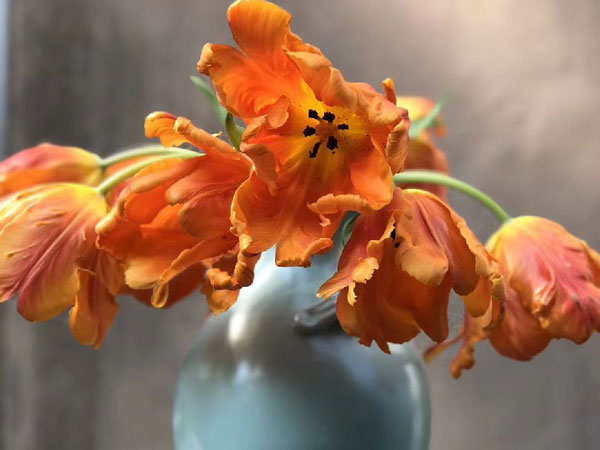Parrot Tulips Profile: Plant Facts & Care Tips
Written by Iris
Dec 11 2021

The parrot tulip bulb has unique beauty features that most traditional tulips lack. Parrot tulips have a pleated appearance and produce flowers with a unique pattern. Parrot tulip petals are not straight, often curly or twisted, and often have stripes or stripes of different colors. Exotic as these tulips look, they are easy to grow and make great cut flowers. Plant in the fall and enjoy the late spring flowers.
The optimum temperature for tulip growth and flowering was 15 ~ 20℃. Flower bud differentiation occurs during the summer storage period when bulbs are removed from the basin and placed outside in the cool shade as the stems and leaves turn yellow. The suitable temperature for differentiation was 20 ~ 25℃, and the maximum temperature could not exceed 28℃.
Tulips are long-sunshine flowers, which prefer sunny, warm and humid winters and cool and dry summers. Cold resistance is very strong, in cold areas, if there is thick snow cover, bulbs can be in the open winter, but afraid of heat, if summer comes early, midsummer is very hot, it is difficult to sleep after the bulb summer.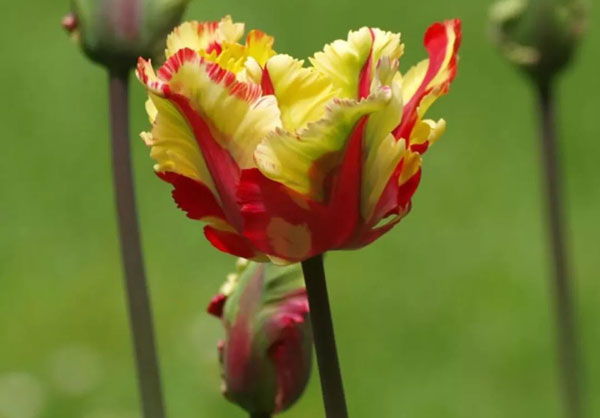
One such aberration was due to Arabis mosaic, aka Tulip Mosaic Virus, spread by aphids. It caused random, vivid color striations across the tepals – this is the catch-all word for the inner petals as well as the outer sepals.
Another anomaly, possibly a mutation of a late-blooming variety, had the fragrant, ruffled, and striated tepals of today’s parrot, though with a weaker stem.
The highly sought after “broken” flowers contributed to a “tulip mania” in the Netherlands in the 1600s, where bulbs became more expensive than houses.
By the early 20th century, breeders had cultivated improved versions with wonderful color combinations and tepal characteristics, as well as stronger stems that would make them quite marketable.
The name “parrot” is said to represent not only the flower's “plumage,” but also its beak-like bud.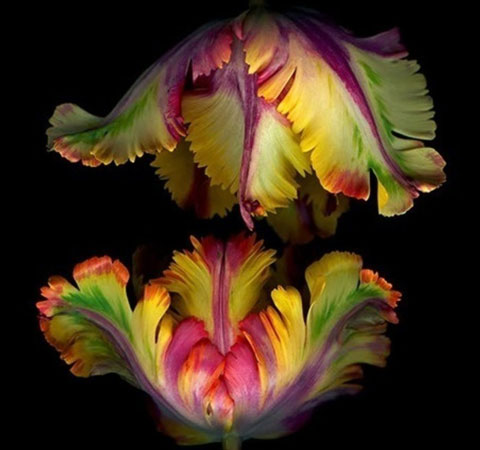
Gather seeds at the end of the blooming season once the tulip's oblong seed pod has dried out.
Start the tulip seeds in autumn, once nighttime temperatures fall to between 40 and 50 degrees Fahrenheit. Use 6-inch nursery pots with drainage holes at the base and rich potting soil. Prepare one pot for every five seeds you want to start. Fill the pots with soil. Sow the tulip seeds at a depth of 1/2 inch. Space them a couple of inches apart and water deeply. Seed-propagated tulips can take up to five to seven years to bloom, so you'll have to wait a long time to see what color and shape the flowers will be.
Choose a sunny garden bed with fast-draining soil. Tulip bulbs should be spaced 1 to 6 inches apart in garden beds, so choose a planting location with enough space to accommodate all of the bulbs you intend to plant. Closer spacing.
Loosen the soil to a depth of 8 to 12 inches and amend it with a few inches of compost, if the soil is poor. Tulip bulbs must be buried deep in order for them to bloom, so dig an 8-inch-deep planting hole for each bulb.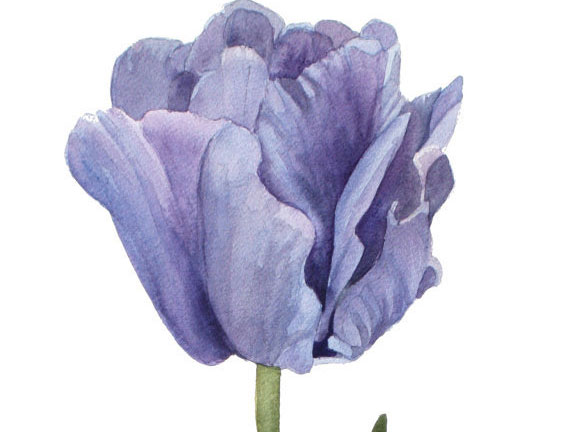
Apricot Parrot
With oversized apricot and pink tepals streaked with green and yellow, this winner of the Royal Horticultural Society’s Award of Garden Merit is a spectacular addition to the spring garden.
Black Parrot
This deep purple, feathery-edged beauty adds a dramatic touch to the spring landscape. It’s easy to see why this variety was awarded the RHS Award of Garden Merit.
Blue Parrot
Large, bright blue-purple blooms with a light purple interior and fringed edges make this cultivar a beautiful addition to borders or cut flower arrangements.
Rococo
A winner of the Japan Bulb of the Year Award in 2003, ‘Rococo’ adds a burst of color with flame-like blooms of red-orange with scalloped margins.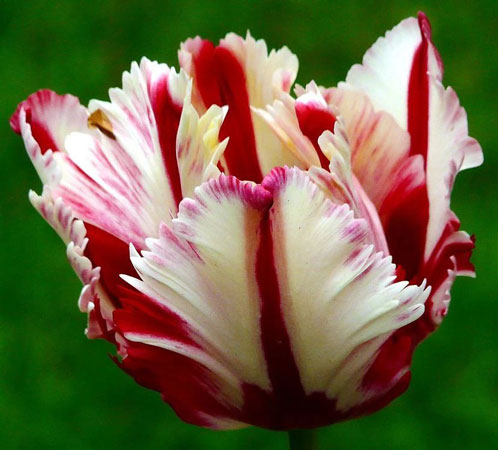
Botrylis blight: This fungal disease is also known as mycelial neck rot or tulip fire. It affects all parts of the tulip, including blooms, stems, and leaves. Usually, the fungus manifests as discolored spots on the surface of the flowers and leaves, as well as lesions on the bulbs. The stem may also collapse.
Pythium root rot: This disease will stop new shoots from emerging. The bulbs will also develop soft gray or brown spots.
Stem and bulb nematodes: If you see spongy brown spots on your bulbs, it may be due to nematodes. They’ll also be mealy and rotted on the inside.
Most tulip diseases are caused by contaminated soil or water. You can prevent these issues from occurring in the first place by using new, high-quality soil and clean water. Always remove the affected plants and, if the problem was fungal, spray the remaining ones with the fungicide of your choice. Don’t replant in areas that have been associated with a disease.
Parrot Tulips PictureParrot Tulips InfoEcological Habits of Parrot TulipsParrot Tulips HistoryHow to grow and care for Parrot TulipsHow to Grow Parrot TulipsHow to Care for Parrot TulipsVarieties of Parrot TulipsParrot Tulips Common Pests/DiseasesParrot Tulips Companion Plants
Parrot Tulips Picture
Parrot Tulips Info
| Botanical Name | Tulipa gesneriana var. Dracontia |
| Common Names | Parrot Tulips |
| Plant Type | Perennial |
| Mature Size | 1–3 ft. tall, 1–2 ft. wide |
| Sun Exposure | Full |
| Soil Type | Moist, well-drained |
| Soil pH | Acidic |
| Bloom Time | Spring, summer, fall |
Ecological Habits of Parrot Tulips
Tulips are native to the high mountains of Iran and Turkey. Due to the Mediterranean climate, tulips adapt to the characteristics of cold and wet in winter and hot and dry in summer. They have the characteristics of dormancy in summer, rooting and germination of new buds but not excavated in autumn and winter. After the low temperature in winter, tulips start to extend and grow to form stems and leaves in early February (the temperature is above 5℃) and bloom in March to April.The optimum temperature for tulip growth and flowering was 15 ~ 20℃. Flower bud differentiation occurs during the summer storage period when bulbs are removed from the basin and placed outside in the cool shade as the stems and leaves turn yellow. The suitable temperature for differentiation was 20 ~ 25℃, and the maximum temperature could not exceed 28℃.
Tulips are long-sunshine flowers, which prefer sunny, warm and humid winters and cool and dry summers. Cold resistance is very strong, in cold areas, if there is thick snow cover, bulbs can be in the open winter, but afraid of heat, if summer comes early, midsummer is very hot, it is difficult to sleep after the bulb summer.

Parrot Tulips History
The Tulipa genus traces its origins to the ancient Ottoman Empire, where these plants were retrieved from the wild for ornamental cultivation.One such aberration was due to Arabis mosaic, aka Tulip Mosaic Virus, spread by aphids. It caused random, vivid color striations across the tepals – this is the catch-all word for the inner petals as well as the outer sepals.
Another anomaly, possibly a mutation of a late-blooming variety, had the fragrant, ruffled, and striated tepals of today’s parrot, though with a weaker stem.
The highly sought after “broken” flowers contributed to a “tulip mania” in the Netherlands in the 1600s, where bulbs became more expensive than houses.
By the early 20th century, breeders had cultivated improved versions with wonderful color combinations and tepal characteristics, as well as stronger stems that would make them quite marketable.
The name “parrot” is said to represent not only the flower's “plumage,” but also its beak-like bud.

How to grow and care for Parrot Tulips
How to Grow Parrot Tulips
- With Seeds
Gather seeds at the end of the blooming season once the tulip's oblong seed pod has dried out.
Start the tulip seeds in autumn, once nighttime temperatures fall to between 40 and 50 degrees Fahrenheit. Use 6-inch nursery pots with drainage holes at the base and rich potting soil. Prepare one pot for every five seeds you want to start. Fill the pots with soil. Sow the tulip seeds at a depth of 1/2 inch. Space them a couple of inches apart and water deeply. Seed-propagated tulips can take up to five to seven years to bloom, so you'll have to wait a long time to see what color and shape the flowers will be.
- With Bulbs
Choose a sunny garden bed with fast-draining soil. Tulip bulbs should be spaced 1 to 6 inches apart in garden beds, so choose a planting location with enough space to accommodate all of the bulbs you intend to plant. Closer spacing.
Loosen the soil to a depth of 8 to 12 inches and amend it with a few inches of compost, if the soil is poor. Tulip bulbs must be buried deep in order for them to bloom, so dig an 8-inch-deep planting hole for each bulb.
How to Care for Parrot Tulips
- Light
- Soil
- Water
- Temperature and Humidity
- Fertilizer
- Pruning

Varieties of Parrot Tulips
There are more than 50 different cultivars of T. gesneriana var. dracontia, in colors that range from nearly black to orange, pink, purple, red, white, and yellow, as well as multicolored variations.Apricot Parrot
With oversized apricot and pink tepals streaked with green and yellow, this winner of the Royal Horticultural Society’s Award of Garden Merit is a spectacular addition to the spring garden.
Black Parrot
This deep purple, feathery-edged beauty adds a dramatic touch to the spring landscape. It’s easy to see why this variety was awarded the RHS Award of Garden Merit.
Blue Parrot
Large, bright blue-purple blooms with a light purple interior and fringed edges make this cultivar a beautiful addition to borders or cut flower arrangements.
Rococo
A winner of the Japan Bulb of the Year Award in 2003, ‘Rococo’ adds a burst of color with flame-like blooms of red-orange with scalloped margins.

Parrot Tulips Common Pests/Diseases
Once you've successfully nurtured your tulips to full bloom, you probably want them to last all season or perhaps even multiple seasons. The last thing you need is a pesky disease affecting your flowers. Here are a few of the most common diseases to be aware of in tulips.Botrylis blight: This fungal disease is also known as mycelial neck rot or tulip fire. It affects all parts of the tulip, including blooms, stems, and leaves. Usually, the fungus manifests as discolored spots on the surface of the flowers and leaves, as well as lesions on the bulbs. The stem may also collapse.
Pythium root rot: This disease will stop new shoots from emerging. The bulbs will also develop soft gray or brown spots.
Stem and bulb nematodes: If you see spongy brown spots on your bulbs, it may be due to nematodes. They’ll also be mealy and rotted on the inside.
Most tulip diseases are caused by contaminated soil or water. You can prevent these issues from occurring in the first place by using new, high-quality soil and clean water. Always remove the affected plants and, if the problem was fungal, spray the remaining ones with the fungicide of your choice. Don’t replant in areas that have been associated with a disease.
Parrot Tulips Companion Plants
Tulips are lovely with other spring bloomers and with each other. Mertensia virginica is a sweet companion and Tulips are perfect planted beneath ground covers like Epimedium or Vinca. Underplant Tulips with Forget-Me-Nots for a classic combination.Latest Updated
- Benefits of Bugleweed - 7 Science-backed Health Benefits
- Bugleweed Dangers & Side Effects - Is It Poisonous?
- How to Plant Evergreen Trees - What You Should Know
- When to Plant Evergreens - Grow Guide for Evergreen Trees
- 12 Wonderful Evergreen Shrubs for Your Garden
- 12 Popular Evergreen Plants with Pictures for Beginners
- When And How To Prune A Lilac Bush Like a Pro
- How to Grow & Care for Lilac Vine (Hardenbergia Violacea)
- Japanese Lilac Tree (Syringa Reticulata) Care & Propagation Guide
- Shumard Oak Pros and Cons - What to Know
Popular Articles
- Winter maintenance of Antirrhinum Majus
- How to Grow Terminalia Mantaly Tree
- How to Grow and Care for Crossostephium Chinense
- How to grow Antirrhinum Majus in spring
- Peristeria Elata (Dove Orchid) Profile: Info & Care Guide
- Underwatered Snake Plant (Sansevieria Trifasciata) - Signs And How To Fix
- How to Care for Brazilian Jasmine Plant (Mandevilla Sanderi)
- How to Grow & Care for Graptopetalum Purple Delight in Summer
- Rosa Chinensis (China Rose): Plant Growing & Care Tips
- How to Care for Baby Sun Rose (Aptenia Cordifolia)
